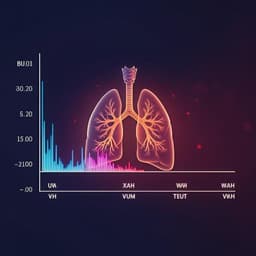
Environmental Studies and Forestry
Catastrophic impact of extreme 2019 Indonesian peatland fires on urban air quality and health
M. J. Grosvenor, V. Ardiyani, et al.
Tropical peatland fires in Indonesia during the El Niño-related droughts severely degrade air quality, leading to over 87,000 estimated excess deaths nationwide in 2019 due to fire-induced PM2.5 exposure. This impactful research conducted by Mark J. Grosvenor, Vissia Ardiyani, Martin J. Wooster, Stefan Gillott, David C. Green, Puji Lestari, and Wiranda Suri highlights the urgent need for fire prevention and landscape remediation.
~3 min • Beginner • English
Introduction
The study investigates the urban air quality and health impacts of extreme Indonesian tropical peatland fires, focusing on Palangka Raya (Central Kalimantan) during the 2019 El Niño–influenced fire season. Peat soils in Kalimantan and Sumatra are highly combustible when dry, producing exceptionally high PM emissions dominated by smouldering combustion. In the absence of rain during severe fire episodes, PM<sub>2.5</sub>-laden haze can persist and spread regionally, degrading air quality across Southeast Asia. Despite the importance, in-situ measurements are scarce near major fire sources, leading to reliance on air quality models (e.g., CAMS) whose performance under extreme smoke conditions is uncertain. This study aims to (1) deploy a dense network of low-cost PM sensors within an urban area close to the fires to quantify extreme PM<sub>2.5</sub> levels and spatial variability, (2) evaluate CAMS model performance under these conditions, and (3) estimate associated health impacts, thereby informing mitigation and health-protection strategies.
Literature Review
Prior catastrophic events (e.g., 1997, 2015) highlighted the transboundary air pollution from Indonesian peat fires and led to regional policy responses (ASEAN Agreement on Transboundary Air Pollution). Modeling studies suggest Indonesian peatland fires can drive some of the world's worst air quality, with fire-sourced PM<sub>2.5</sub> linked to substantial morbidity and mortality. Roberts and Wooster (2021) estimated ~678,000 premature deaths annually globally from landscape fire PM<sub>2.5</sub>, with ~39% in children under five. Xue et al. (2021) reported that a 1 µg m<sup>−3</sup> increment of fire-sourced PM<sub>2.5</sub> is associated with a 2.31% increased risk of under-five mortality, implying ~28,900 excess child deaths per year in Indonesia. Uda et al. (2019) estimated ~648 additional deaths per year in Central Kalimantan from fire-sourced PM<sub>2.5</sub> (2011–2015). However, these estimates generally rely on modeled PM<sub>2.5</sub> concentrations, with limited validation under extreme haze near source regions. Validation of CAMS outputs has been limited primarily to lower concentration ranges or sparse individual sensors (e.g., embassy sites), creating uncertainty in health impact assessments for severe fire seasons. Low-cost optical PM sensors (e.g., PurpleAir/Plantower) have proliferated, enabling dense spatial sampling, but require environment-specific calibration due to aerosol composition, humidity, and high concentration effects.
Methodology
Study area and period: Palangka Raya, Central Kalimantan, Indonesia. The 2019 fire season (August–October) was exacerbated by a weak El Niño and featured extensive nearby peatland burning.
Sensor network: Ten PurpleAir PA-II-SD sensors (each with dual Plantower PMS5003 detectors, A and B) were installed across the city primarily at Primary Health Care and Midwifery Centres plus one Borough Office with a fixed AQMS. Installations were 2.5–4 m above ground, away from immediate local PM sources. Data were logged nearly continuously from ~20 August to 22–25 October 2019.
Co-location and calibration: Pre-deployment co-location at Palangka Raya Airport BMKG station (15–18 August 2019) and post-deployment check (27 October 2019) assessed inter-sensor consistency and drift. Gravimetric reference PM<sub>2.5</sub> (24 h) was obtained using MiniVol samplers with pre-conditioned Teflon-coated quartz filters weighed on a Mettler Toledo MX5. A mass adjustment factor (AF) specific to tropical peat smoke was derived by regressing PurpleAir outputs against MiniVol PM<sub>2.5</sub> (slope = 0.49; intercept = 0), closely matching earlier DustTrak-based AF for this environment. Laboratory combustion chamber tests with tropical peat in King’s Wildfire Testing Chamber characterized high concentration behavior; a 0.67 reduction was applied for readings >1000 µg m<sup>−3</sup>. Data processing included: UTC-to-local conversion; temperature/humidity offset corrections; A/B detector comparison (averaging if within 10% or selecting the better-performing channel otherwise); flagging RH >75% readings and values >500 µg m<sup>−3</sup> for higher uncertainty.
Satellite fire and land cover: VIIRS 375 m active fire detections and fire radiative power (FRP) characterized fire activity and proximity; land cover mapping (Gaveau et al. 2016) contextualized fire locations relative to land types (e.g., scrubland vs forest) and protected areas (Sebangau National Park).
Model comparison: CAMS EAC4 reanalysis PM<sub>2.5</sub> (0.75° grid; 3-hourly) and CAMS Near Real Time (0.4° grid) were averaged over grid cells covering Palangka Raya (intersection of four EAC4 cells; nine NRT cells to approximate area). City-mean in-situ PM<sub>2.5</sub> (sensor network average) was compared to model means over the broader area to evaluate temporal agreement and magnitude biases, recognizing representativeness issues due to grid scale, fire distribution, and wind direction.
Air quality metrics: 24-h mean PM<sub>2.5</sub> was converted to US EPA AQI categories per site and day to assess severity and spatial variability within the city.
Health impact assessment: Following Johnston et al. (2012), excess attributable mortality due to chronic exposure to fire-specific PM<sub>2.5</sub> was computed: C = M × (RR(PM − CF) − 1), where M is expected deaths (from World Bank death rates and gridded population; exposure cell population ~679,000), PM is annual mean smoke-specific PM<sub>2.5</sub> (from CAMS; capped at 50 µg m<sup>−3</sup> per method limitations), and CF is counterfactual (0 for human-ignited fires). Background non-fire PM<sub>2.5</sub> used non-fire season means. Estimates were produced for the Palangka Raya exposure cell across 2003–2019, and extended to Central Kalimantan and to Kalimantan+Sumatra for 2015 and 2019. Additional cause-specific estimates using Crippa et al. methodology are provided in supplementary materials.
Key Findings
- Extreme urban PM2.5 levels and variability: The network recorded severe smoke pollution with 3-hour means exceeding 700 µg m<sup>−3</sup> citywide on 14–16 September 2019. The mean PM<sub>2.5</sub> across sites for 20 Aug–24 Oct was 137 µg m<sup>−3</sup>, far above WHO 24-h (then 25 µg m<sup>−3</sup>, now 15 µg m<sup>−3</sup>) guidelines. Diurnal cycles showed early-morning peaks (~06:00) due to nocturnal boundary layer suppression, with a secondary late afternoon peak.
- Air Quality Index (AQI) severity: Only 1 day during the season was ‘Good’. Most days were ‘Unhealthy’ (30) or ‘Very Unhealthy’ (15), with 8 ‘Hazardous’ days (6 H1, 2 H2) and several days exceeding the maximum AQI (>500). Spatial differences were substantial: one site (Tanjung Pinang) had 20 ‘Hazardous’ days vs 3 at Kereng. Sites farther from the city center and away from wetlands/protected forests tended to be worse.
- Sensor performance and calibration: PurpleAir sensors showed good inter-device agreement (mean A–B channel difference ~1.4%), stability over the season, and—after applying a peat-smoke-specific AF (0.49) and high-concentration adjustment (0.67× above 1000 µg m<sup>−3</sup>)—provided reliable high-temporal-resolution PM<sub>2.5</sub> data in extreme conditions.
- Model evaluation (CAMS): In-situ vs CAMS EAC4 showed strong temporal agreement (r ≈ 0.80) and reasonable magnitude alignment overall, with CAMS overestimating on high-pollution days (>100 µg m<sup>−3</sup>) by a mean of ~35%, and being ~5% lower on days <100 µg m<sup>−3</sup>. Peak discrepancies were linked to fires within the CAMS cells but upwind of the city sensors. CAMS NRT had lower agreement (r ≈ 0.70) and tended to underestimate vs in-situ on high days by ~66% on average.
- Health impacts: Using CAMS-derived smoke-specific annual PM<sub>2.5</sub> and Johnston et al. methodology, the Palangka Raya exposure cell had an estimated 1,223 excess deaths in 2019 (and 1,341 in 2015). Extensions yielded 3,276 excess deaths across Central Kalimantan and 51,377 across Kalimantan+Sumatra in 2019 (4,910 and 75,014 respectively in 2015). The abstract reports more than 87,000 excess deaths nationwide in 2019. CAMS-estimated annual mean PM<sub>2.5</sub> for the region was 56 µg m<sup>−3</sup>, implying substantial long-term risk increases relative to WHO guidelines.
Discussion
The study demonstrates that dense low-cost sensor networks can quantify extreme PM<sub>2.5</sub> exposure and its intra-urban variability near Indonesian peat fires—conditions underrepresented in traditional monitoring networks and challenging for models. The observed early morning PM<sub>2.5</sub> maxima highlight meteorological controls (boundary layer dynamics) on exposure timing, with practical implications for public health guidance (e.g., window management, timing of outdoor activities). CAMS EAC4 performed relatively well given the severity and spatial heterogeneity, capturing temporal evolution but showing magnitude biases that depend on concentration levels and synoptic smoke transport relative to the city. These evaluations build confidence in using CAMS for exposure and health assessments while underscoring the importance of local measurements for calibration and situational awareness. The mortality estimates reveal large population health burdens in severe fire years (2015, 2019), emphasizing the public health significance of peatland fire management and mitigation. The findings also stress the need to refine exposure–response functions for high-concentration smoke exposures beyond commonly studied urban ranges, and to improve model representativeness at sub-grid urban scales in complex fire environments.
Conclusion
This work provides the first city-scale, near-source networked measurements of extreme peat-fire smoke in Palangka Raya during 2019, calibrates low-cost sensors for tropical peat smoke, and evaluates state-of-the-art CAMS PM<sub>2.5</sub> under life-threatening air quality conditions. It quantifies severe exposure (mean ~137 µg m<sup>−3</sup> over two months), strong spatial and diurnal variability, and substantial excess mortality (over 1,200 in the Palangka Raya region and thousands more across Central Kalimantan; tens of thousands regionally). CAMS shows relatively strong performance overall but with concentration-dependent biases and representativeness limitations during peak events. Policy and practice implications include urgent actions to reduce ignition (e.g., curbing fire use), rewetting and remediating degraded peatlands, strengthening local monitoring using calibrated low-cost networks, and issuing evidence-based public health advisories that reflect diurnal exposure patterns. Future research should refine high-exposure risk functions, assess indoor/outdoor infiltration and protection strategies, integrate sensor networks with models and satellites for real-time decision support, and enhance model resolution and fire emissions characterization to better capture urban-scale impacts.
Limitations
- Sensor and calibration constraints: Optical PM sensors require environment-specific adjustment factors; performance degrades at very high concentrations and high humidity (RH >75%), although laboratory and field adjustments (AF=0.49; 0.67× above 1000 µg m<sup>−3</sup>) were applied. The AQMS reference had calibration issues and may itself need a smoke-specific AF.
- Temporal and spatial coverage: The in-situ campaign covered August–October 2019; annual exposure outside the fire season was not directly measured. Sensor deployment gaps occurred due to power interruptions.
- Model representativeness: CAMS grid cells include areas beyond the city; wind direction and clustered fires can produce divergence between city measurements and cell-mean model estimates. The model does not explicitly separate fire vs non-fire PM components in outputs.
- Health impact methodology: The Johnston et al. approach caps smoke PM at 50 µg m<sup>−3</sup> and relies on exposure–response relationships developed largely at lower concentration ranges, potentially underestimating impacts at extreme exposure. Population and mortality rates are gridded estimates and may carry uncertainties.
- Generalizability: Results are specific to Palangka Raya and 2019 conditions; land cover and fire dynamics vary spatially and interannually.
Related Publications
Explore these studies to deepen your understanding of the subject.







